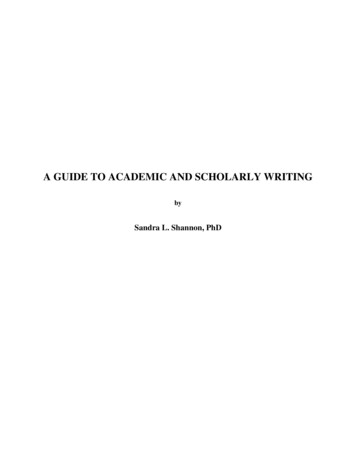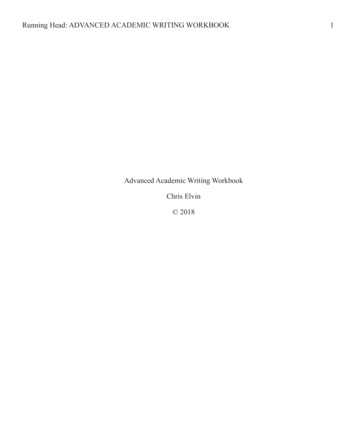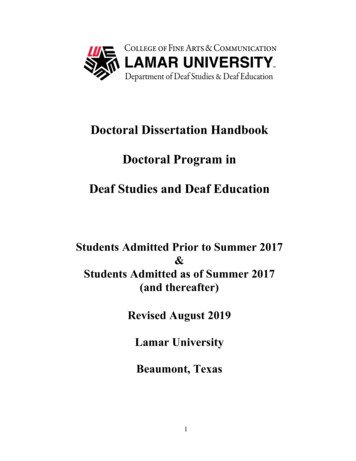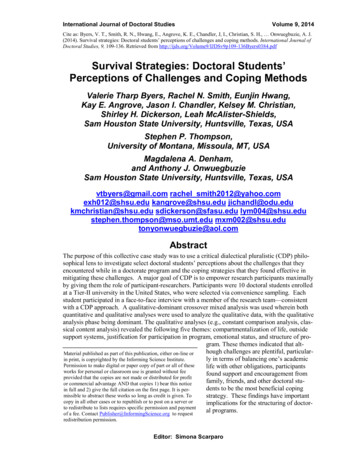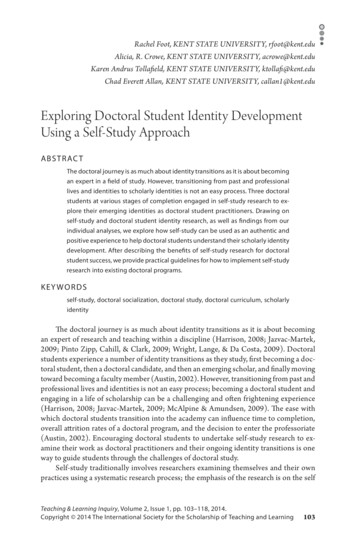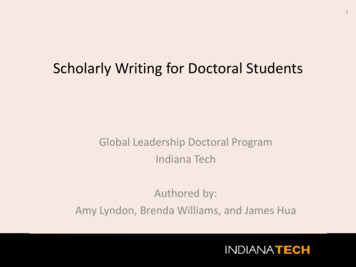
Transcription
1Scholarly Writing for Doctoral StudentsGlobal Leadership Doctoral ProgramIndiana TechAuthored by:Amy Lyndon, Brenda Williams, and James Hua
Objectives and Announcement Tips Writing style–––––Clarity in writingArgument structureGrammarAvoiding Biased LanguageHelpful writing resources APA style, general– Formatting– Structure– Heading levels Citations Quotations (single, block) References–––– Depending upon yourneeds,– You can review only thesections you need, or– Review the entirepresentation It’s all up to you, as thisis a long presentationPrimary & Secondary SourcesPersonal CommunicationsElectronic SourcesUnusual Sources Proofreading2
3Writing tips When staring at a blank screen – Don’t start with the first sentence. Start with thesecond or third. Don’t put too much pressure onyourself at the start.– If you’re trying to figure out what to say,1. Turn your head away from the screen,2. Ask yourself, “What am I trying to say?”3. Say it. And then write it down. It’s highly probablythat’s exactly what you need to say.
4WRITING STYLEConcise phrasing, active voice, argument structure, avoiding bias, andgrammar
Concise phrasing5
Clarity in Writing: Concise PhrasingScientific writingshould be readable.Your arguments try topersuade the reader;such arguments areuseless if the readercan’t comprehendyour meaning. Keep itsimple, clear, andconcise.VerboseConciseHas the capability ofIs capableFewer in numberFewerIs indicative ofIndicatesIs capable ofCanMake use ofUseIs of interest toInterestsConsensus of opinionConsensusExact duplicateExactlyIs a benefit toBenefits6
Clarity in Writing: Concise Phrasing EditsOverly verboseMore conciseWith the beginning of the new ‘80’s, it isreadily ascertainable that there hasbeen little if any improvement in theoverall national or general localeconomy. It is expected by someeconomists that a general upturn on thenational level should come aboutsometime during mid-19801. However,with the increase in taxes starting inJanuary, mainly an increase in socialsecurity, this will reduce the amount offree funds available for the stimulationof consumer spending.In 1980 we saw little if any improvementin the economy, national or local, andalthough some economists expect anupturn in mid-1981, the tax increasesscheduled to begin in January, mainlyfor social security, will leave consumerswith less money to spend.7
Clarity in Writing: Active voice Passive: Verbcomes beforesubject Active: Subjectcomes before verb Active voice givesstronger voice,reducesunnecessarywords, and makesclearerarguments.PassiveActiveThis paper was written bymeI wrote this paperThe shelter will be ownedby the town, but it will berun by members of thehumane society andsupported, in part, by fundsraised by them. The bulk ofthe operating funds,however, will be suppliedby the town.Although the town will ownthe shelter and pay most ofthe operating expenses,members of the humanesociety will run the facilityand provide additionalsupport through fundraising.8
Argument StructureWilliams, J. M., & Colomb, G. C. (2003) The craft of argument: Concise edition. NY: LongmanIn general, each paragraph should consist of an argument:1. Claims–What’s your point? What are you saying in a nutshell?What conclusion have you come to after reading theresearch?2. Reasons–Why should I agree with you? What reasons can you offerto support your claim/conclusion?3. Evidence– On what facts do you base those reasons? How do weknow they are good reasons? What evidence do you haveto back them up?9
Argument StructureGlass, C., & Cook, A. (2016). Leading at the top: Understanding women’s challenges above the glass ceiling.The Leadership Quarterly, 27, 51-63.1. Claims– Women leaders are often promoted to riskypositions.2. Reasons– Women may face less competition from men forthese positions,3. Evidence– as qualified white male candidates may view thesepositions as too risky or otherwise undesirable(Rryan & Haslam, 2007).10
11Argument StructureWilliams, J. M., & Colomb, G. C. (2003) The craft of argument: Concise edition. NY: Longman Distinguishing claims and reasons– Main claim: the one claim that states the solution to the problemthat the whole argument addresses. It’s the main pointof the whole argument, the statement the rest of theargument supports.– Claim Any statement supported by a reason– Reason Any statement that supports any claim – main orotherwise.
12Argument StructureWilliams, J. M., & Colomb, G. C. (2003) The craft of argument: Concise edition. NY: Longman Violence on television and in video games shouldbe reduced (claim 1) because children who watchlots of violent entertainment tend to becomeviolent adults (reason 1 supporting claim 1). Theybecome so used to constant images of casualviolence that they assume it’s just part of dailylife (reason 2 supporting claim 1, citation). Forexample children who view aggressive televisionclips demonstrate lower levels of arousal thanchildren who view nonaggressive clips (evidencein support of reason 2 – and citation).
Avoiding Bias Conducting research oftenrequires researchers to work witha variety of populations, some ofwhom tend to be stereotyped bythe use of labels and other biasedforms of language. Therefore,APA offers specificrecommendations for eliminatingbias in language concerning race,disability, and sexuality. Be sensitive to labels andrespectful of preferences. Sexual orientation is not the sameas sexual preferences. Disability etiquette suggests, “PersonFirst Language”– People with disabilities– People who are deaf– People who are blindOther groups:– Elderly describe the age group.It is better to give age ranges– Ages 65-85Racial Identity: preferences change,but be consistent in usage:– Blacks/African Americans– Hispanics/Latinos– American Indian/NativeAmericans
Gendered Pronouns APA does not recommend replacing "he" with "he or she," any othervariation, including alternating between "he" and "she" because thesesubstitutions are awkward and can distract the reader from your point.The pronouns "he" or "she" inevitably cause the reader to think of onlythat gender, which may not be what you intend. To avoid the bias of using gendered pronouns:– 1) Make the subject plural (e.g., “participants”) instead of individual(e.g., “each participant”), 2) then use "they" or "their"– Replace the pronoun with an article - instead of "his," use "the"– Drop the pronoun - many sentences sound fine if you just omit thetroublesome "his" from the sentence– Replace the pronoun with a noun such as "person," "individual,""child," "researcher," 0/ )
Mechanics of Writing StyleThese links hold the answers; use the writing resources listed below, as well.Word choice Affect vs. effectYour vs. you’reThat vs. whichWhile vs. althoughWhile vs. sinceGrammar Apostrophes Semi-colons Commas, especially Oxfordcommas em-dash Hyphens Single vs. double quotationmarks What requirescapitalization?15
16Helpful Sources on Writing Patricia O’Conner (2003). Woe is I: The grammarphobe’s guide to betterEnglish in plain English. NY: The Berkley Publishing Group. Bruce Ross-Larson (1996). Edit yourself: A annual for everyone who workswith words. NY: W.W. Norton & Company. Joshua Schimel (2012). Writing science: How to write papers that get citedand proposals that get funded. NY: Oxford University Press. Paul J. Silvia (2007). How to write a lot: A practical guide to productiveacademic writing. Washington, DC: American Psychological Association. Paul J. Silva (2015). Write it up: Practical strategies for writing andpublishing journal articles. Washington, DC: American PsychologicalAssociation. William Strunk, Jr. & E. B. White (2000). The elements of style, 4th edition.Needham Heights, MA: Allyn & Bacon. Joseph M. Williams & Gregory G. Colomb. (2003). The craft of argument:Concise edition. NY: Addison Wesley Longman, Inc. William Zinsser. (2006). On writing well. The classic guide to writingnonfiction. NY: HarperCollins Publishers.
17APA STYLELinks, citations, formatting, sections of an empirical paper, references
18APA Style Links Basics of APA Style Tutorial from APA– http://flash1r.apa.org/apastyle/basics/index.htm Online writing lab at Purdue (OWL)– / Home base for more unusal APA style questions– http://blog.apastyle.org/apastyle/ DOI Retriever (for your References)– https://doi.crossref.org/simpleTextQuery
Major Sections of an APA Paper Title Page Abstract Body of the Paper References
20General Formatting– 1” margins all around– Double-space everything– Times New Roman 12-point font– One space after punctuation (not two)– Header and page number on top right (shortenedtitle)– No bold or underline; italics are rarely used– No extra spaces between paragraphs or sections
Research Paper Outline ss.html )The hourglass widens and the researcher concludes and generalizes the findingsto the real world.
Components of a PaperPurposeClearly describes contentsEnsures recognition for the writer(s)Describes what was done – 150 wordsEnsures the article is correctly identifiedKey Words (some journals)in abstracting and indexing servicesExplains the problemIntroductionExplains how the data were collectedMethodsDescribes what was discoveredResultsDiscusses the implications of the findingsDiscussionEnsures those who helped in the researchAcknowledgementsare recognisedEnsures previously published work isReferencesrecognisedProvides supplemental data for the expertAppendices (some journals)readerSectionTitleAuthorsAbstract
Title Page Page header (see video) Running head– A shortened title Title (50 characters or less) Author Institution Taken 0/ )
HeadingsLevel One:Centered, Boldface, Uppercase and LowercaseLevel Two:Flush Left, Boldface, Uppercase and LowercaseLevel Three:Indented, boldface, lowercase paragraph ending with a period.Level Four:Indented, boldface, italicized, lowercase paragraph headingending with a period.Level Five:Indented, italicized, lowe4rcase paragraph heading ending with aperiod.
Abstract Helps the reader decide whetherto read the paper Indiana Tech requiresdissertation abstracts of 350words or less. Non-dissertations suggest arange from 150-250 words. Abstracts provide an overview ofthe dissertation to include:– Purpose, design, method,theoretical or conceptualframework, findings and overallconclusion. Each abstract isdifferent; your Chair will guideyou in terms of what is preferred.
26Indiana Tech’s Guidelines To find out what information goes in whichlocation (and in what order) for the QP and theDissertation, review the guidelines in the Ph.D.Student Handbook:– https://phd.indianatech.edu/studenthandbook/ Qualifying Paper Guidelines Dissertation Manual PhD Program Plagiarism Policy
27CITATIONS
Citations:Parenthetical citations are preferredIn-text According to Carroll andLevy (2010), leadershipdevelopment must beengendered as a uniqueidentity.– Focuses on the authors, notthe facts.– It obscures the argument– It slows down the readerParenthetical Leadership developmentmust be engendered as aunique identity (Carroll &Levy, 2010).– Focuses on the information,not the authors.– But the authors are stillcredited– Makes a smoother, morereadable argument28
Citations Three to Five Authors: List all the authors the first time you cite thesource.– Parenthetical: (Kernis, Cornell, Sun, Berry, & Harlow, 1993)– in-text: Kernis, Cornell, Sun, Berry, and Harlow (1993)– Use In subsequent citations, only use the first author's last namefollowed by "et al."– (Kernis et al., 1993) or Kernis et al. (1993)– Note: In et al., et should not be followed by a 2/10/ ) Six or more authors: Use “et al.” immediately.
30Secondhand Citations Always* cite the originator of the information you refer toin your paper,– Which is not always the source where you read it.– Reading facts cited by another person is like a game of gossip –you don’t know the accuracy of the information from a thirdparty source. Many authors have been mis-cited by trustingsecondhand accounts by third parties (including this author!) Therefore, if you see an interesting fact from author A,cited by Author B’s paper, always* READ the original AuthorA instead of relying on a third-party Author B’s accounts. * exceptions are if the source is completely unavailable –but use extremely rarely.– If you MUST use a secondhand citation: (Author A, as cited inAuthor B); (White, 1978, as cited in Kadlec, 2010).
31
32REFERENCES
References Type References on the top centerSources appear in alphabetical orderHanging indent is used (see video)First word of citation should correspond within-text citation
Journal Article Author’s Last Name,Initial of Author’s FirstName. (Year ofPublication). Title ofarticle. Title ofPublication, VolumeNumber(IssueNumber), PageNumbers. DOI # Murphy, S.E. & Johnson,S.K. (2011). Thebenefits of a long-lensapproach to leaderdevelopment:Understanding seeds ofleadership. TheLeadership Quarterly,22(3): 459-470. DOI:10.1016/j.leaqua.2011.04.00434
Print Book Author’s Last Name,Initial of Author’s FirstName. (Year ofPublication). Title ofbook. Location ofPublisher: Name ofPublisher. Lipson, C. (2008). Doinghonest work in college:How to preparecitations, avoidplagiarism, andachieve real academicsuccess. Chicago:University of ChicagoPress.35
Government Document Author or Department.(Year). Title of work.(Report No.). Location:Publisher. National Institute ofMental Health.(1990). Clinical trainingin serious mentalillness (DHHSPublication No. ADM90-1679). Washington,DC: U.S. GovernmentPrinting Office.36
Website Author, A. (year). Titleof website [Descriptionof form]. Retrievedfrom URL. American CancerSociety. (2015). Cancerstatistics [web page].Retrieved x37
Unusual, but necessary citationsand references Personal Communications: letters, memos, emails, messages, messages form blogs, etc. Are cited in-text, but not on the reference page.– T. K. Lutes (personal communication, April,18, 2001).– (B. C. Williams, personal communication,August 10, 2008). Brochures:Research and Training Center on Independent Living.(1993).Guidelines for reporting and writing aboutpeople with disabilities (4th ed.) [Brochure].Lawrence, KS: Author. Diagnostic and Statistical Manual of MentalDisorders:American Psychiatric Association. (1994). Diagnosticand statistical manual of mental disorders (4thed.). Washington, DC: Author. No date:Lovejoy, S. (n.d.). Workers with disabilities: Disabilitydisclosure. Retrieved February 6, 2006, losure/ Audio Recording:Costa, P. T. Jr. (Speaker). (1998). Personality,continuity, and changes of adult life(Cassette Recording No. 207-433-88A-B).Washington, DC: American PsychologicalAssociation. Television series:Miller, R. (Producer). (1989). The mind[Television series]. New York: WNET. Paper Presented at a Meeting orSymposia:Culter, L. D., Frolich, B., Hanrahan, P. (1997,January 16). Two-handed directmanipulation on the responsiveworkbench. Paper presented at the 1997Symposium on Interactive 3D Graphics.Abstract retrieved June 12, 2000, ded/
References Organization as AuthorAmerican Psychological Association. (2003). Unknown AuthorMerriam-Webster's collegiate dictionary (10th ed.).(1993). Springfield, MA: MerriamWebster. Two or More Works by the Same Author– Use the author's name for all entries and list the entries by theyear (earliest comes first).Berndt, T.J. (1981). Age changes and changes over time in prosocial intentionsand behavior between friends. Developmental Psychology, 17, 408-416.Berndt, T.J. (1999). Friends’ influence on students’ adjustment to school.Educational Psychologist, 34(1), 15-28.
References Two or More Works by the Same Author in the Same Year– If you are using more than one reference by the same author (or the samegroup of authors listed in the same order) published in the same year,organize them in the reference list alphabetically by the title of the articleor chapter. Then assign letter suffixes to the year. Refer to these sources inyour essay as they appear in your reference list, e.g.: "Berdnt (1981a)makes similar claims.“Berndt, T. J. (1981a). Age changes and changes over time in prosocialintentions and behavior between friends. Developmental Psychology, 17,408-416.Berndt, T. J. (1981b). Effects of friendship on prosocial intentions andbehavior. Child Development, 52, 636-643.
41Reference Details Capitalization:– Capitalize all proper nouns (e.g., American), thefirst word in the title, and the first word after acolon– Do not capitalize any other word in the articletitle. Leadership development: A review in context.– DO capitalize every major word in the journal title. The Leadership Quarterly
42Proofreading StyleWriteathome.com– Is every sentence clear and easy to understand?– Do my sentences and paragraphs connect coherently witheffective transitions from argument to argument?– Do I employ mostly strong action verbs or do I rely toomuch on weak “be” verbs?– Is my writing economical and concise? Which sentencescan I shorten to make it more effective?– Do I say something new and important in each sentence ordo I repeat myself?– In every sentence, do I say what I intend to say or do Isettle for something close?– Do I use direct quotes rarely and do I paraphraseeffectively?
43ProofreadingWriteathome.com Grammar/usage– Are all my sentences complete? Any fragments,comma splices, or run-ons?– Is my verb tense consistently appropriatethroughout the paper?– Do all my verbs agree with their subjects?– Are the antecedents for all my pronouns clear? Isit clear what the pronouns refer to?
44ProofreadingWriteathome.com Word choice/diction– Do I use the precise word every time?– Can I replace any word with one that is more precise,clear, or vivid?– Am I aware of the connotations of the words I use?– Have I left out any words I meant to include? Have Ileft in words I meant to delete?– DoI avoid technical jargon and slang potentiallyunfamiliar to my reader(s)?– Do I avoid clichés and bland, overused expressions?– Have I eliminated all unnecessary adjectives andadverbs?
45ProofreadingWriteathome.com Mechanics and formatting– Have I spelled everything correctly (use, but don’ttrust the spell-checker, as it won’t catch everything)– Does every sentence end in correct punctuation?– Have I followed rules for comma use?– Have I correctly punctuated and formatted allquotations?– Have I capitalized properly?– Have I avoided unnecessary abbreviations?– Are all my paragraph breaks where they should be?
Writing style –Clarity in writing –Argument structure –Grammar –Avoiding Biased Language –Helpful writing resources APA style, general –Formatting –Structure –Heading levels Citations Quotations (single, block) References –Primary & Secondary
